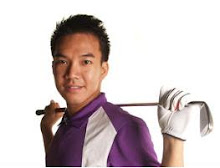Traditional golf instruction has a golfer move his head to the right in an attempt to "coil", get a bigger "X Factor" or "Y Factor" or "O". On the surface, while it seems that this is reasonable, it actually creates more faults than it cures.
At address, before the golfer does anything, he has actually matched his head position and more specifically his left shoulder with the ball position. To move the head and as corollary, the left shoulder - which is the low point of the swing, where the club bottoms out - one would then have to move the ball to maintain this synchronicity, or risk hitting it thin or fat.
What typically happens then is that the golfer will either have to sway his head and left shoulder back to the left on the downstroke or "get stuck" if he doesn't have the adequate physical capability to sway back on time.
The first option has its own pitfalls, instead of a "pure" sway that is the mirror opposite of how he moved his head to the right, Joe Hacker will utilize the right shoulder in a roundhouse fashion and cut across the correct swing plane.
Another thing that can happen is that he overcooks the sway and moves his low point way ahead of the ball and hit half tops. This of course is a better option than hitting it fat as the ball should run out to almost where it would be had it been struck properly.
The most egregious of effects produced by a moving head would be its companion, the dip as the golfer initiates the downswing. The end result of which is a fat shot, or if the golfer bends the left wrist or left elbow to prevent bottoming out before impact, weak, high powerless shots.
The next time you get to the range, watch to see if your head is moving out of position. The head should be centered between your feet, the way it would be when you are brushing your teeth.
On your backswing, the head should feel centered while your back should feel like its turning to face the target. From there, the downswing should be reflexive with plenty of lag. Hold your finish as your shot takes off with a crack like an F14 taking off into the distance.
skip to main |
skip to sidebar


For beginner golf lessons in Singapore, email info@asiangolfinstitute.com.sg and quote "Justin Tang"
About Me

- Justin Tang
- Justin Tang has been involved in golf for over 10 years and became the 1st authorized Medicus Instructor in Asia in 2005. He holds an Honours degree from the University of London where he topped his cohort in Applied Psychology, winning the prestigious John Mann Award. He also holds a diploma in Engineering. His involvement and association with Homer Kelley’s The Golfing Machine (TGM) began in 2000 after being frustrated with the lack of progress in his game and the amount of misinformation surrounding golf instruction. Justin specializes in teaching students simply how to hit the ball straight and long through the correct understanding and application of geometry and physics. Since then, he has spent time with world famous PGA instructors the likes of Ben Doyle, Chuck Evans, Gregg McHatton, Lynn Blake, Dana Dahlquist, Dennis Alberts, Mal Tongue, Bob McDonald and Shane Scott. He is the only instructor in the region to offer a MONEY BACK GUARANTEE on lessons He can be reached at +65-8188-1701 or via email at jtang@medicusgolfinstitute.com
As Featured In...
As featured in Golf, China Golf Magazine, Indo Golf Magazine, Iseekgolf Australia, Singapore Business Review, Channel Newsasia, News 5, Berita Suria...
Mission Statement
Search Justin Tang Golf
Student Testimonials
"Turned what I know about traditional golf instruction on its head. I still have a hard time coming to terms with how I actually believed that...hopefully I can reach my dream of playing scratch golf."
Chip Bronson
Canada
Chip Bronson
Canada
“Justin is clear in explaining why certain things workand why others don't. His teaching methods includecolourful analogies and visuals - the key to impartinga lasting impression when we are talking about acomplex motion like the golf swing. They help me toremember certain important positions when I practice. His instruction is predicated on science, nothingwill go wrong if you execute accordingly, in factyou'll end up playing like a machine and enjoying thegame more than you do now. I know I am. “
Alex Yeoh
Singapore
Alex Yeoh
Singapore
“Dear Justin, I want to relate my weekend game last sat... After practicing the on plane pitching action with only sand wedge, I proceeded with caution to my regular sat foursome.But no need to fear. Awesome results! Shot an easy 80 at Kranji. Never have I been able to hit a 3 wood off the turf so consistently and accurately. And my pitched 3 wood went further than “normal” due to flushed contact with clubhead lag! The sound coming off some of my irons were pure. Also the in to out path stroke makes ‘over the top’ impossible to achieve.Now if I can only get to the full swing!. Golf nirvana beckons haha”
Patrick Seow
Singapore
Patrick Seow
Singapore

Site Counter
Justin Tang can be contacted for individual or group lessons and corporate clinics at +65-8188-1701 or via email at jtang@medicusgolfinstitute.com


No comments:
Post a Comment